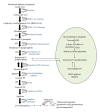Phytochemical and pharmacological properties of Gymnema sylvestre: an important medicinal plant
- PMID: 24511547
- PMCID: PMC3912882
- DOI: 10.1155/2014/830285
Phytochemical and pharmacological properties of Gymnema sylvestre: an important medicinal plant
Abstract
Gymnema sylvestre (Asclepiadaceae), popularly known as "gurmar" for its distinct property as sugar destroyer, is a reputed herb in the Ayurvedic system of medicine. The phytoconstituents responsible for sweet suppression activity includes triterpene saponins known as gymnemic acids, gymnemasaponins, and a polypeptide, gurmarin. The herb exhibits a broad range of therapeutic effects as an effective natural remedy for diabetes, besides being used for arthritis, diuretic, anemia, osteoporosis, hypercholesterolemia, cardiopathy, asthma, constipation, microbial infections, indigestion, and anti-inflammatory. G. sylvestre has good prospects in the treatment of diabetes as it shows positive effects on blood sugar homeostasis, controls sugar cravings, and promotes regeneration of pancreas. The herbal extract is used in dietary supplements since it reduces body weight, blood cholesterol, and triglyceride levels and holds great prospects in dietary as well as pharmacological applications. This review explores the transition of a traditional therapeutic to a modern contemporary medication with an overview of phytochemistry and pharmacological activities of the herb and its phytoconstituents.
Figures

References
-
- Grover JK, Yadav S, Vats V. Medicinal plants of India with anti-diabetic potential. Journal of Ethnopharmacology. 2002;81(1):81–100. - PubMed
-
- Burke JP, Williams K, Narayan KMV, Leibson C, Hafener SM, Stern MP. A population perspective on diabetes prevention: whom should we target for preventing weight gain? Diabetes Care. 2003;26(7):1999–2004. - PubMed
-
- Smith CM, Reynard AM. Essentials of Pharmacology. Philadelphia, Pa, USA: WB Saunders; 1995.
Publication types
MeSH terms
Substances
LinkOut - more resources
Full Text Sources
Other Literature Sources
Medical

